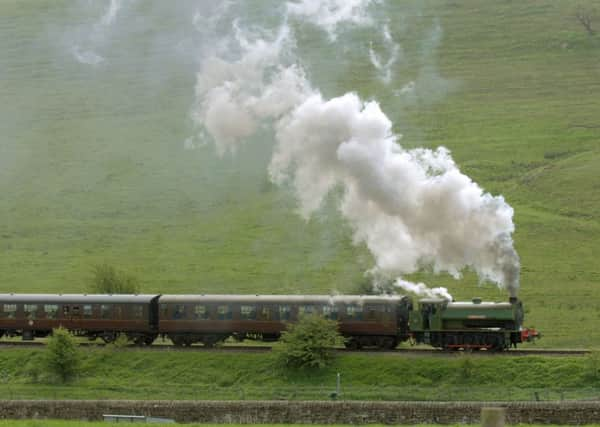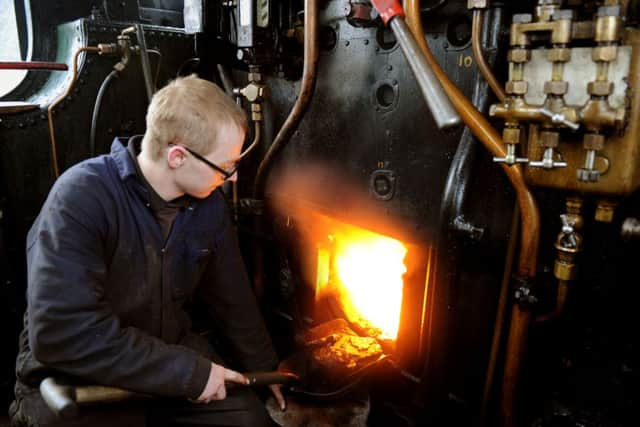Through the Dales by rail


A LOT of patience is required to run a preserved railway. Little happens quickly, and progress is measured in years and decades rather than weeks or months.
Ask Stephen Walker, the general manager of the Embsay and Bolton Abbey Steam Railway. It’s 40 years since he first became involved as a teenager, and the pace of progress has been as steady as one of the vintage locomotives making its way through the Dales.
Advertisement
Hide AdAdvertisement
Hide AdOver that period, the line has more than quadrupled in length, to four miles, but it’s a measure of the need for patience that it equates to an extra mile every 10 years.


Stephen isn’t complaining, however. There’s more left to do, including the most ambitious development yet, but it should happen in time and for him the magic of the line running through one of the loveliest parts of Yorkshire is as strong as it was when he first arrived.
There’s a homely feel about this railway. Swallows are nesting in the eaves of Bolton Abbey Station, which also has a couple of resident cats, and an owl has made its home there as well.
In the cafe, a giant teddy bear that Stephen bought to raffle to raise funds has instead been seated permanently at one of the tables because it’s proved so popular with visitors who snap photographs of each other having a cup tea with it.
Advertisement
Hide AdAdvertisement
Hide AdThat homely atmosphere draws visitors back for regular visits, and a couple of them, Lynne White, from Pool-in-Wharfedale, and her friend Shirley Moran, from Rawdon, became so fond of it that they volunteered to run the cafe.
“The people are so friendly,” said Lynne. “It’s like a new family, the kids love it, and we get some really good feedback. You get to know people, because they come back over and over again.”
They are among the 100,000 people a year who make their way to the railway, which operates for 155 days annually. The route dates from 1888, and is part of the Ilkley to Skipton line that, like so many others, fell victim to the Beeching cuts of the 1960s, when pushing more cars and lorries onto the narrow roads of the Dales was presented as progress.
Volunteers began the slow process of bringing the line back to life as a heritage railway in 1968, starting with just a quarter-of-a-mile of track from Embsay, and gradually extending, relaying the lost track.
Advertisement
Hide AdAdvertisement
Hide AdBolton Abbey Station had been flattened when the railway acquired the site in 1992, but with the help of construction giant Sir Robert McAlpine, it was recreated as it had looked in 1888.
There are echoes of that distant era in the operation of the railway, as Stephen, 55, dashes from selling tickets out onto the platform to whistle the train away to Embsay. “I’m the business manager during the week and then the stationmaster at the weekend,” he said.
“It’s not the trains, it’s the railway for me. There’s a magic about the place and always has been, and I think that’s why we get quite a few people who come regularly. I like trains, but I couldn’t tell you what engine pulls what, but there’s a friendliness about this place. “I’ve always liked the personality of the railway, there’s a nice rapport with the passengers.”
They come for the magic of steam, but just how long ago it is since these vintage engines and the carriages they pull were everyday sights is underlined when some try to get on board, according to driver John Furness, 55, of Harrogate. “A lot of people nowadays struggle with the carriage door locks, because they don’t understand them,” he said.
Advertisement
Hide AdAdvertisement
Hide AdToday John and fireman Roger Sinar, 74, from Hornsea, are aboard a locomotive with an impeccable Yorkshire pedigree – built by Hudswell Clarke in Leeds in 1942, it worked in the Stocksbridge steelworks near Sheffield before being moved to Cadeby Colliery, near Doncaster.
It’s named Jennifer, but it’s no lady. “It is,” says John, “a bit of a thug”, a rugged industrial locomotive that tends to jerk the train about, but Roger, who’s firing it for the first time, says admiringly that it steams well.
Jennifer is typical of the locomotives that run on the line, all of them industrial engines, which have the merit of being relatively economical to operate. Even so, keeping the line running is costly. Just moving the train up and down the line costs £1,000 a day in coal, and that’s before insurance premiums.
Another locomotive is awaiting restoration, which is going to cost £100,000, and a fundraising drive is under way. It’s part of Yorkshire industrial history – the last steam engine to operate at a British pit, working at Wheldale Colliery, near Castleford, right into the 1980s.
Advertisement
Hide AdAdvertisement
Hide Ad“Money, it’s always been about money,” said Stephen. “We’ve always struggled for money, but we’ve always managed to get there in the end.”
He became the railway’s manager in 1990, and drew up a plan for developing the line which is still being followed.
Now, it’s time to work at the next stage of the plan – to extend the line the two miles from Embsay into Skipton, which would cost about £2m and involve collaborating with Network Rail, not only at the town’s station, but over the interaction between the heritage line and a freight route. And that’s the complicated part. “Physically, it’s very easy,” said Stephen. “You could do it in a weekend, but that would be without train control. The signalling is the expensive bit, it has to be controlled from York.”
But linking up with the main-line network at Skipton would be a huge boost for the railway – and for the tourist trade in the Dales, potentially taking pressure off the roads, especially as the frequency of public transport has declined. Ten years ago, the railway was on the route of 27 buses every Saturday. Now there are none, even though visitors love this part of the Dales.
Advertisement
Hide AdAdvertisement
Hide Ad“We have noticed the last two or three years that people are staying a lot longer,” said Stephen. “Maybe it’s the recession, but they have a day out on the railway, have a ride, walk to Bolton Abbey, come back and have a second ride.”
The recession has meant that funding for the extension into Skipton has been hard to come by, but Stephen is hopeful that as the economy picks up, it will happen, perhaps in the next five years.
It’s just another stage in the railway’s steady progress that has taken 40 years so far. But it’s been worth it, said Stephen.
“I think we’ve got a good future. It’s difficult times for everybody, but I don’t think heritage railways will ever go bust because there is a magic about them.
Advertisement
Hide AdAdvertisement
Hide Ad“It’s a lovely working environment, and it’s something that’s hopefully going to be here for generations to come, so you’ve achieved something. Hopefully, in a hundred years, people will still be coming.”
• For more information go to www.embsayboltonabbeyrailway.org.uk